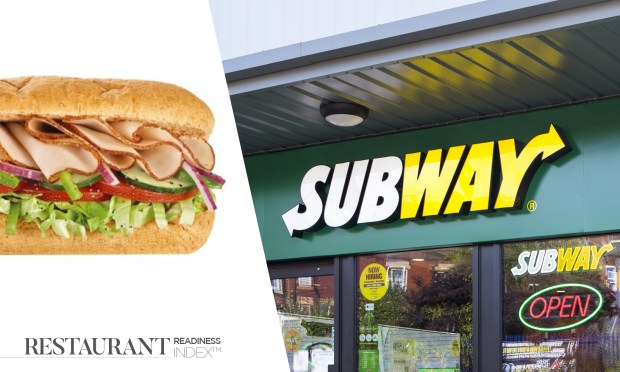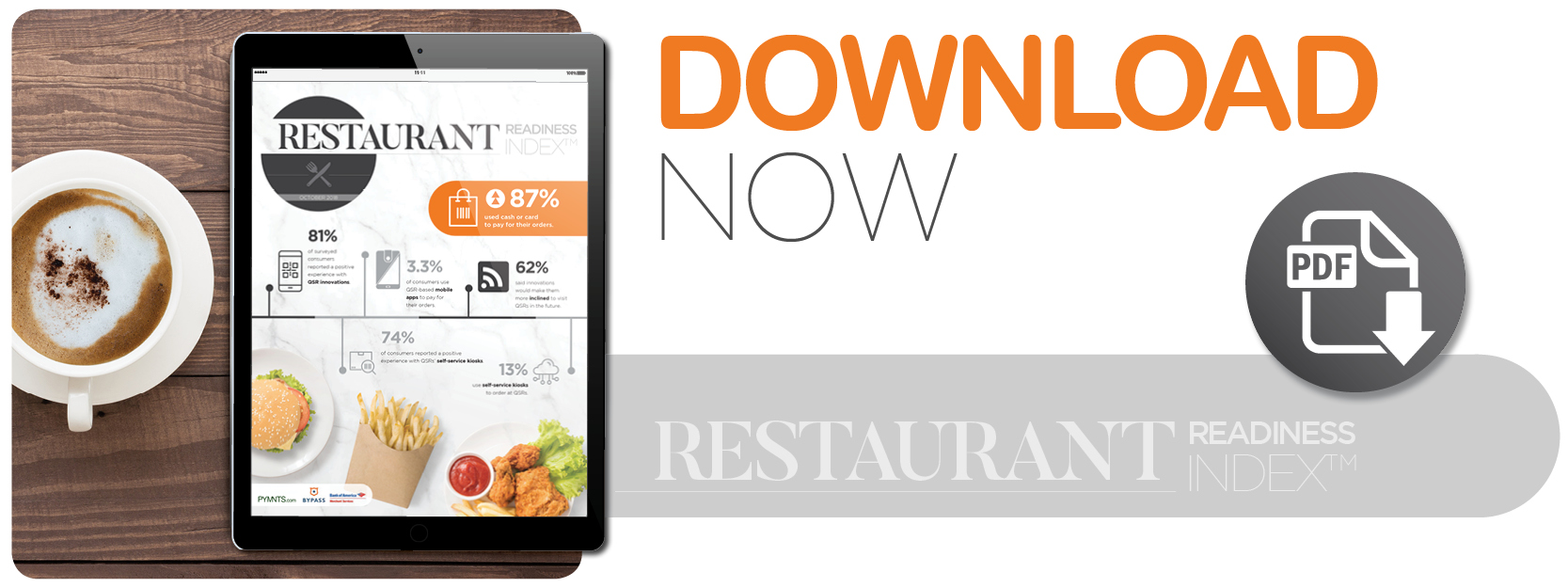Subway Seeks To Innovate, Reworking Kiosks, Loyalty And Mobile

For insight on how QSRs are responding to changing customer expectations, PYMNTS caught up with Carissa Ganelli, chief digital officer at Subway. She discussed the new technologies the franchise is currently testing — including kiosks, apps and loyalty programs — at its nearly 30,000 locations in the U.S. and Canada, plus the innovation cues it’s taking from outside the restaurant industry.
Speed and convenience have long been top reasons why consumers are drawn to quick-service restaurants (QSRs). Consumers expect fast, efficient service that barely requires them to look up from their smartphones, and the modern QSR needs to innovate accordingly.
More consumers are using mobile ordering to get their meals, and many choose where they order from based on the availability of those features. Winning over that crowd can mean working with third-party services, changing loyalty models and making sure the digital experience is just as quick and easy as it is in a physical store.
For insight on how QSRs are responding to changing customer expectations, PYMNTS caught up with Carissa Ganelli, chief digital officer at Subway. She discussed the new technologies the franchise is currently testing — including kiosks, apps and loyalty programs — at its nearly 30,000 locations in the U.S. and Canada, plus the innovation cues it’s taking from outside the restaurant industry.
Attention To Innovation
QSRs have always marketed their fast service, but eCommerce has trained consumers to expect service that’s even faster, effortless and, most importantly, digital.
“Consumer expectations were set outside of the QSR industry when it comes to digital,” Ganelli said, pointing to the recent innovations made by eCommerce retailers, which have pioneered these new channels and techniques. “The reason why it spilled over into QSRs is because consumers expected to have one-click purchasing, like on Amazon, the ability to swipe left or swipe right, like on Tinder [and] a robust loyalty program, like at Sephora.”
According to Ganelli, QSRs have “no choice” but to innovate — QSRs that don’t will be left out when it comes time for consumers to choose a restaurant. Introducing technologies like robust digital apps for ordering meals, for pickup and delivery, has become necessary.
“This is where we are in QSR. Do we really need to have mobile apps? When our food is given to the consumer in a retail environment across a counter, we don’t really need that. They still have to come in,” Ganelli pointed out. “But we need it because consumers are expecting [it].”
Since 40 percent of consumers don’t know what they’re going to eat in the first hour of lunchtime, and 63 percent use their mobile phones to make that decision, fulfilling mobile expectations is key.
“If we’re not there, we’re not in consideration,” she said.
Creating a mobile experience
As more customers start to organize their daily lives online and with their smartphones, QSRs must also make a move toward the internet. This means examining what technologies customers already use in their daily lives and crafting an experience to match, using technology that might already be available in-store. Ordering at a kiosk, for instance, could easily be replicated on mobile.
“At what point do you look and say your smartphone is a kiosk? We’re still trying to determine what the right balance is [between mobile and in-store],” Ganelli said, pointing to the continuing consumer preference for mobile across retail.
She added, “There’s a certain percentage of people who are going to download our app, so [Subway] wants to be there. There’s a higher percentage of people who are going to purchase through the web, whether it’s a desktop or mobile experience. We’re at about one-third mobile app, two-thirds web.”
The typical user that downloads its mobile app is already a frequent Subway customer, and while the QSR has not shared specific customer or transaction figures, the chain’s digital transactions doubled from August 2017 to July 2018.
Revamping The Loyalty Program
Customers are expecting faster services, but they don’t want more speed to come at a higher cost. Generally, low prices are expected from QSRs, and this is only increasing as the industry gets more competitive. One way to solve for greater speed and lower prices is with loyalty based discounts. According to the PYMNTS Restaurant Readiness Index, loyalty programs are increasingly being offered by QSRs.
Subway launched its digital and in-store MyWay Rewards program for North American customers in March 2018. Since then, the program has been growing rapidly. MyWay replaces an older, more limited version, and comes with features that are online or mobile-only. The updated program is a result of more consumers expecting greater interaction with their chosen brands, and that this interaction will save them money.
“We had an old loyalty program that was only in one-third of our markets, and our enrollment rate [for MyWay] is 10 times what the old program was,” Ganelli said. Membership numbers for the MyWay Rewards program is in the “multi-millions” — she would not share specific numbers.
Customers already know what they want, and QSRs should shape their loyalty programs accordingly. Most customers want speed and for their order to come out correct, at a discount that feels personal.
“Consumers in general, and certainly for Subway, … [know] what they want, when they want it [and] how they want it, and they want it for a deal,” Ganelli said. She pointed to several third-party coupon apps outside the QSR industry, such as RetailMeNot, as examples of the demand for discounts.
MyWay has paid off for Subway, which is seeing more engagement from customers involved in the loyalty program than those who are not.
“With 100 days of data, we [saw] a 16 percent lift in [visitor] frequency among our loyalty members, and that is conservative,” Ganelli said.
Digital Changes To The Physical Store
With innovation as a necessity, QSRs need to modernize in a few ways to fulfill customer expectations. Most are approaching this with the addition of self-service kiosks in their stores.
Like many QSRs, Subway is in the midst of a brand overhaul — and sating a customer’s need for speed means not just crafting an immersive mobile app and online customer experience, but using kiosks to upgrade the look, feel and experience of its physical locations.
“In some of our restaurants, we have self-service kiosks. We’ve found that some consumers walk into our restaurants, go right to the kiosks and have no interest in interacting with the restaurant staff,” Ganelli said.
Subway is “driving incrementality” for customer visits through the self-service kiosks, but the choice of whether to engage with new online features or in-store experiences is entirely up to the customer.
“[It’s] more about how consumers self-select,” she remarked.
To determine the success of the kiosks, Subway reviewed order tickets, finding that consumers who used them tended to spend more. They may have bought smaller sandwiches, but they purchased more of the add-ons or used the “make it a meal” option more often.
Looking Ahead
Subway isn’t just responding to current consumer expectations — it’s trying to anticipate how those expectations will continue to change so it can be ready for them. One major area of change may be customer engagement via third-party channels.
“In the long-term, we’re going to move away from native apps,” she said. “Even today, native apps are only big in North America and in Western Europe. In Latin America and [Asia-Pacific] APAC, most consumers are interacting with third-parties like Alibaba, WeChat [and] WhatsApp.”
Chinese consumers’ preferences for such services have been well-observed. Alibaba’s Alipay, which has over 500 million monthly users, has become a marketplace for goods and services outside of just payments, where it started.
“Instead of developing a native app, [QSRs will] just get integrated into those flows, because that’s where the customers are,” Ganelli said. “For the foreseeable future, will [Subway] have a mobile app? Yes. In 10 years, will we? I have no idea. … Maybe all of the buying [will] be through third-parties.”
Like most QSRs, Subway has not only aimed to fulfill present customer needs, but anticipated future ones. That’s why Ganelli is keeping a close eye on mobile app developments, voice assistants and other emerging technologies. For QSRs looking to expand their digital technology use, it might be a good idea to keep an eye on Subway.

